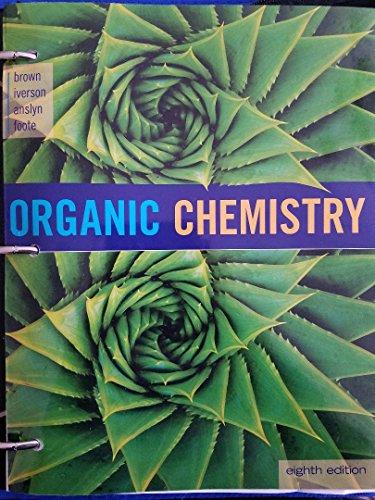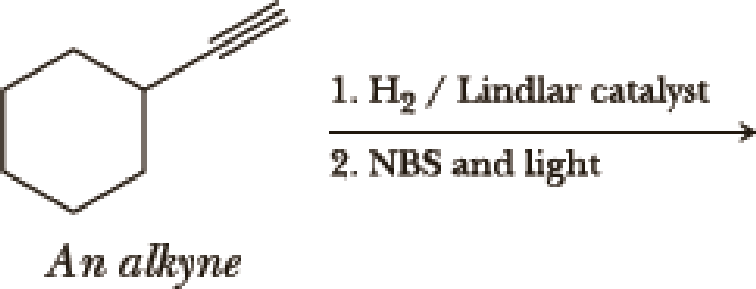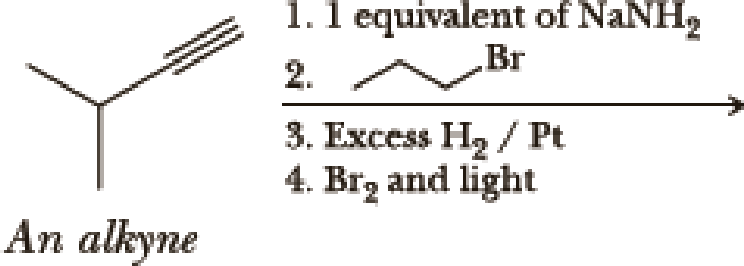
Concept explainers
Write the products of the following sequences of reactions. Refer to your reaction road-map to see how the combined reactions allow you to “navigate” between the different





(a)
Interpretation:
The product of the given reaction has to be determined.

Concept Introduction:
Hydrogenation of alkynes:
Treatment of an alkyne with

Bromination to alkanes:
Bromination to alkanes is addition of bromine in alkanes. This reaction proceeds via radical formation in the presence of light or high heat by chain mechanism. The reaction proceeds in three steps which are chain initiation, chain propagation and chain termination respectively. In first step of chain initiation bromine radical (

Explanation of Solution
The product is,

The first step is the hydrogenation to alkynes that gives alkane, here propane.
Second step is the bromination to alkane that gives stable
(b)
Interpretation:
The product of the given reaction has to be determined.

Concept Introduction:
Selective reduction of alkynes:
Hydrogenation of alkynes via the addition of

Allylic bromination:
Allylic bromination is the addition of bromine in allylic carbon atom. A very useful way of allylic bromination is done via NBS in dichloromethane at or slightly above room temperature. Reaction between NBS and alkene is most commonly initiated by light. This reaction involves a net double substitution that is bromine in NBS and hydrogen in alkene which exchange their places.
This reaction also proceeds via radical pathway. The reaction proceeds in three steps which are chain initiation, chain propagation and chain termination respectively. In first step of chain initiation bromine radical (

Explanation of Solution
The product is,

The 1st step is the selective reduction of alkyne that gives alkene.
The 2nd step gives allylic bromination which undergoes via formation of stable allylic radical.
(c)
Interpretation:
The product of the given reaction has to be determined.

Concept Introduction:
Selective reduction of alkynes:
Hydrogenation of alkynes via the addition of

Allylic bromination:
Allylic bromination is the addition of bromine in allylic carbon atom. A very useful way of allylic bromination is done via NBS in dichloromethane at or slightly above room temperature. Reaction between NBS and alkene is most commonly initiated by light. This reaction involves a net double substitution that is bromine in NBS and hydrogen in alkene which exchange their places.
This reaction also proceeds via radical pathway. The reaction proceeds in three steps which are chain initiation, chain propagation and chain termination respectively. In first step of chain initiation bromine radical (

Explanation of Solution
The product is

The 1st step is the selective reduction of alkyne that gives alkene.
The 2nd step gives allylic bromination which undergoes via formation of stable allylic radical. Here the allylic radical is much more stable due to presence of ring as much more conjugation will be there to stabilize the radical more.
(d)
Interpretation:
The product of the given reaction has to be determined.

Concept Introduction:
Hydrogenation of alkynes:
Treatment of an alkyne with

Bromination to alkanes:
Bromination to alkanes is addition of bromine in alkanes. This reaction proceeds via radical formation in the presence of light or high heat by chain mechanism. The reaction proceeds in three steps which are chain initiation, chain propagation and chain termination respectively. In first step of chain initiation bromine radical (

Explanation of Solution
The product is,

In the 1st step
In 2nd step simple substitution occurs as the bromine of alkene is taken up by the proton removed in 1st step and thus the carbanion formed in 1st step simply can attack the alkyl bromide and substitution product is formed.
The 3rd step is reduction of alkynes giving alkanes.
In 4th step bromination in alkane occurs. Here the attack by bromine radical will be more on left side on the tertiary carbon as then only
So this will be the major product.
(e)
Interpretation:
The product of the given reaction has to be determined.

Concept Introduction:
Chlorination to alkenes:
Chlorination of alkene forms dichloro alkane. In this reaction alkene acts as electrophile that attacks

Hydrogenation of alkynes:
Treatment of an alkyne with

Bromination to alkanes:
Bromination to alkanes is addition of bromine in alkanes. This reaction proceeds via radical formation in the presence of light or high heat by chain mechanism. The reaction proceeds in three steps which are chain initiation, chain propagation and chain termination respectively. In first step of chain initiation bromine radical (

Explanation of Solution
The product is,

The 1st step is the chlorination to alkene that gives anti product.
In the 2nd step
In 3rd step normal substitution occurs and the carbanion formed in the 2nd step acts as nucleophile and attack alkyl halide.
In the 4th step hydrogenation of alkynes occur to give alkane.
In the last step bromine addition to alkanes occur. As the reaction proceeds via radical formation hence this product is the major product as both the radicals formed in this pathway are
Want to see more full solutions like this?
Chapter 8 Solutions
Organic Chemistry, Loose-leaf Version
- > Can the molecule on the right-hand side of this organic reaction be made in good yield from no more than two reactants, in one step, by moderately heating the reactants? esc ? A O O •If your answer is yes, then draw the reactant or reactants in the drawing area below. You can draw the reactants in any arrangement you like. • If your answer is no, check the box under the drawing area instead. olo 18 Ar Explanation Check BB Click and drag to start drawing a structure. 2025 McGraw Hill LLC. All Rights Reserved. Terms of Use | Privacy Center Accessibilityarrow_forwardName the structurearrow_forward> For each pair of substrates below, choose the one that will react faster in a substitution reaction, assuming that: 1. the rate of substitution doesn't depend on nucleophile concentration and 2. the products are a roughly 50/50 mixture of enantiomers. Substrate A Substrate B Faster Rate X CI (Choose one) (Choose one) CI Br Explanation Check Br (Choose one) C 2025 McGraw Hill LLC. All Rights Reserved. Terms of Use | Privacy A F10arrow_forward
- How to draw this mechanism for the foloowing reaction in the foto. thank youarrow_forwardPredict the major products of the following organic reaction: Some important notes: CN A? • Draw the major product, or products, of the reaction in the drawing area below. • If there aren't any products, because no reaction will take place, check the box below the drawing area instead. • Be sure to use wedge and dash bonds when necessary, for example to distinguish between major products that are enantiomers. No reaction. Explanation Check Click and drag to start drawing a structure. 2025 McGraw Hill LLC. All Rights Reserved. Terms of Use Privacy Centerarrow_forwardDraw the major product of the following reaction. Do not draw inorganic byproducts. H3PO4 OHarrow_forward
- Predict the major products of this organic reaction: HBr (1 equiv) Δ ? Some important notes: • Draw the major product, or products, of this reaction in the drawing area below. • You can draw the products in any arrangement you like. • Pay careful attention to the reaction conditions, and only include the major products. • Be sure to use wedge and dash bonds when necessary, for example to distinguish between major products that are enantiomers. • Note that there is only 1 equivalent of HBr reactant, so you need not consider the case of multiple additions. Explanation Check X ©2025 McGraw Hill LLC. All Rights Reserved. Terms of Use | Privacyarrow_forwardFor the structure below, draw the resonance structure that is indicated by the curved arrow(s). Be sure to include formal charges. :ÖH Modify the second structure given to draw the new resonance structure. Include lone pairs and charges in your structure. Use the + and - tools to add/remove charges to an atom, and use the single bond tool to add/remove double bonds.arrow_forwardUsing the table of Reactants and Products provided in the Hints section, provide the major product (with the correct stereochemistry when applicable) for questions below by selecting the letter that corresponds to the exact chemical structures for the possible product. OH conc Hydrochloric acid 40°C Temp A/arrow_forward
- Using arrows to designate the flow of electrons, complete the reaction below and provide a detailed mechanism for the formation of the product OH conc Hydrochloric acid 40°C Temp All chemical structures should be hand drawn on a piece of paper Paragraph BI UAE +varrow_forwarddraw out the following structures plesearrow_forwardDraw everything on a piece of paper outlining the synthesis from acetaldehyde to 2 cyclopentene carboxaldehyde using carbon based reagants with 3 carbons or fewers. Here is the attached image.arrow_forward
 Organic ChemistryChemistryISBN:9781305580350Author:William H. Brown, Brent L. Iverson, Eric Anslyn, Christopher S. FootePublisher:Cengage Learning
Organic ChemistryChemistryISBN:9781305580350Author:William H. Brown, Brent L. Iverson, Eric Anslyn, Christopher S. FootePublisher:Cengage Learning Macroscale and Microscale Organic ExperimentsChemistryISBN:9781305577190Author:Kenneth L. Williamson, Katherine M. MastersPublisher:Brooks Cole
Macroscale and Microscale Organic ExperimentsChemistryISBN:9781305577190Author:Kenneth L. Williamson, Katherine M. MastersPublisher:Brooks Cole

